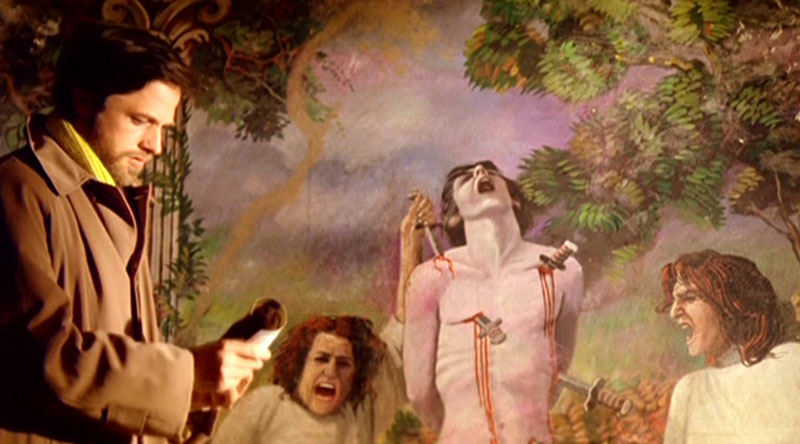
Okay. The Sistine Chapel it ain’t.
This January, in support of the Toronto Rape Crisis Centre / Multicultural Women Against Rape, friends and family have raised over $1,000, which means I have to watch and write about thirty-one horror movies. I’ll watch (on average) one movie a night, many of them requested by donors, after which I’ll write some things about said movies on this website. Be forewarned that all such write-ups will contain spoilers! I tackled the sole giallo film on my January list last night: The House with the Laughing Windows, directed by Pupi Avati (Giovanna’s Father, Revenge of the Dead). The film, like Deadly Blessing, was not a donor suggestion, but another use of a free movie space this month. After all, what is a horror movie marathon without at least one example of those style-over-substance violent Italian mysteries more popularly known as giallo films (or gialli)? The House with the Laughing Windows was rented from Queen Video.
What happens:
The House with the Laughing Windows, which is often considered to be one of the masterpieces of the genre, starts creepily enough: over sepia-toned images of a man, hanging by his arms, being stabbed over and cover, the credits run. A voice like that of an Italian Darth Vader rants about “my colours, my colours … they run hot in my veins.” I’m already scared. We’ll find out what all that’s about later, but first, art restorer Stefano (Lino Capolicchio), who looks like Italian James McAvoy in a trench coat, stands on a ferry to the village in the Valli di Comacchio area of Italy. On the ferry, he locks eyes with a beautiful raven-haired woman, but is soon distracted by the real reason he arrived in this small village: work. The town’s mayor, a little person named Solmi (Bob Tonelli) greets him at the dock, and he and his driver, Coppola (Gianni Cavina) bring him into town.
Solmi goes over Stefano’s task: to restore a fresco in the church of Saint Sebastian, painted by local artist, Buono Legnani, who died twenty years ago. (Given the painting is only twenty years old, I’m not sure why it requires restoration, but maybe it’s that humid Mediterranean climate?) Legnani’s paintings are one of the key tourist attractions of the village, so Solmi, who has done much to bring unity and prosperity to the area, is keen to revive them. The other key attraction in the village? The silence. Stefano visits the church and meets the priest, who notes the church has been through a lot – even used by the S.S. during World War II. He believes the rumours that Legnani was insane and isn’t 100% excited about restoring the art. Stefano, however, is immediately impressed upon seeing the work: “What an artist, to illustrate death so well …. he understood everything.”
Stefano starts on the restoration at once, and quickly meets adult altar boy (?), Lidio (Pietro Brambilla), who is busy polishing a staff (which is, surprisingly, not a euphemism). Stefano is later brought to his hotel room and quickly meets a redheaded woman in the hallway, whom the porter unsubtly suggests is a sex worker. Before he can even open his suitcase, he receives a phone call. A crone-like voice warns him to go away and not touch the painting. Stefano cools down from that weirdness at the only trattoria in town, ordering his regular meal: a big block of cheese and a coffee. The presumed sex worker asks to join him, but is blocked by Stefano’s old friend Antonio (Giulio Pizzirani), who recommended him for the restoration job. Antonio had a nervous breakdown a while ago but assures Stefano he’s much better now.
He also gives Stefano the lowdown on the woman in his hotel: she’s a schoolteacher and she’s slept with nearly everyone in town. (Though he tells Stefano this in much, much crasser terms than this.) Antonio is alarmed Stefano went to see the painting on his own, and starts to tell him a strange story before Stefano stops him, worried this story is a symptom of his old mental health problems. Next we see Stefano, he’s already lounging on the teacher’s bed as she prepares him tea. He tells her she has a “sad face,” and she just about straddles him after that. (Stefano, you silver-tongued devil!) The next day, Antonio talks to Stefano by the shore, and says he’ll have to finish his story by taking him to the house with laughing windows. (Hey, that’s the title of this movie!) Legnani, he says, was called the “painter of agony.” When Solmi, however, finds out Antonio has been telling him spooky stories, warns him Antonio may not be entirely right in the head.

This is the face Stefano makes through 90% of the movie.
Stefano gets back to work on the fresco. Unfortunately, his work brings him into close proximity with the beyond-creepy Lidio, who entertains him by telling him stories about local molesters (and other such fun anecdotes). When Stefano sees flowers left by the painting, he asks Lidio who delivered them, and Lidio claims he didn’t see. Stefano’s dinner that night is interrupted by the valet, Coppola, quarrelling with the local police – a skirmish that spills into the town’s only restaurant. Mr. Poppi (Andrea Matteuzzi), the restaurant owner, intervenes and tells Coppola to go home, an order which the driver, clearly drunk, obeys. Poppi, a distinguished older man with a moustache, apologizes to Stefano, who he knows is in town to restore the painting. In a small village, he explains, everyone knows everything. He then shows Stefano his house, which features a number of Legnani originals. HIs wife, who now suffers from dementia, was a huge Legnani fan. She even posed for his first painting, though he also notes that Legnani never managed to find women as models, so he started to use himself. (Confusing!) Mrs. Poppi (Flavia Giorgi) now roams the streets on her own, day and night.
After his visit with Poppi, Stefano receives a panicked call from Antonio. He insists that he finish telling him the story about Legnani, so Antonio power-walks to his house, only to see his friend (or a fairly obvious dummy) fall to his death from the top of a building. When the police marshall (Ferdinando Orlandi) interviews Stefano the next morning, Stefano is sure that Antonio was pushed off the building, but the lack of motive or evidence leads the marshall to believe he jumped due to suicidal thoughts. When Stefano returns to his hotel room he receives another phone call – literally the only phone calls the hotel gets are for him – and it’s the same voice, warning him to keep away from the painting.
More bad news at the hotel: one of their best customers will soon be visiting, the manager says, so Stefano is being kicked out. Luckily, creepy Lidio has an idea of a place he can stay. He regales him with ways to prepare rats as meals on their bike ride to a hidden villa. Lidio says he can stay at this massive estate. When Stefano asks who it belongs to, Lidio leads him upstairs to where an old bedridden woman rests. The bedridden woman (Pina Borione) is paraplegic, and Lidio feeds and cares for her, though she quite clearly hates him. (Doesn’t everyone?) Lidio tells the woman that Stefano will be staying for a while, and she’s frankly happy to have the noise around the house. As Stefano checks out of his hotel, he asks the porter who the new guest is, and she says they haven’t had tourists in town for years. (The plot thickens!)
Stefano settles into the large old house. Even though he hears mysterious footsteps in the evening, it’s not so bad. He chats with the paraplegic woman for company, but realizes the flowers in the room are the same as those left near the painting. Arriving home from work late at night, Stefano discovers a secret room at the very top of the house – a large empty concrete room, seemingly decorated with a loose canvas by Legnani. He also finds, hidden under a cloth on a chair, a tape recorder. He takes it to his room and plugs it in, promptly setting the outlet on fire and extinguishing all the lights in the house. (Those darn European electrical outlets!) Nevertheless, the tape recorder begins to play, as if mystically, and the rant about colours from the opening credits returns.
Spooked by the disturbing recording, Stefano wanders the foggy streets and is startled when he nearly runs into Mrs. Poppi. When he returns to his old lover’s room at the hotel, he finds she’s no longer there, but the woman from the ferry is. Francesca (Francesca Marciano) is the new teacher, replacing the previous one at the school. For some reason she’s collected a whole bunch of snails to make escargot, but since she couldn’t bring herself to kill them, they’re slithering around her tub. (Okay then.) They part ways but make plans to meet again. The next day, Stefano’s restoration work is interrupted by the funeral of Antonio. Lidio pulls Stefano aside and says he put a live animal in Antonio’s coffin to keep him company. The small gathering assembled for Antonio’s funeral can hear the scratching from within the pine box.
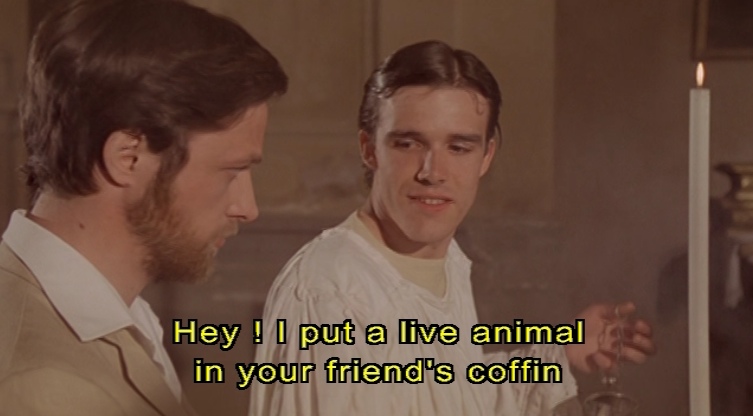
Cool story, bro.
The more Stefano works on the painting, the more he begins to understand Buono Legnani. “He didn’t want to paint the agony of a saint,” he says. “He depicted death.” Stefano asks the priest about the paraplegic woman in the house, and he confesses he doesn’t know much about her. Stefano asks if she was friends with Legnani and the priest is horrified by the thought. When Stefano returns home that night, he can hear the tape recording playing. Francesca is listening to the rant in the dark (as one does); she’s been waiting for him. Stefano makes her a romantic dinner, the only snag of which is when she lends him her lighter, which is engraved with the initials “B.L.” (Could it be Buono Legnani’s lighter?) Otherwise, things go pretty well. Stefano lays on the charm thick and they end up sleeping together. Then he asks her to move in literally after one night together. (Stefano moves fast, ladies and gentlemen.)
Stefano finds an abandoned house and begins to explore it. Before he can get too far, Coppola, the driver, interrupts him. Stefano asks if this was Legnani’s house, and Coppola – refusing to answer – instead offers him a drive into town. Coppola is such an irate drunk that he can no longer get served in town, so Stefano has to buy wine from the restaurant and sneak it out to the valet while he waits at the harbour. Over wine, Coppola tells him what he remembers of Legnani. The painter went to Brazil at some point with his mother and two sisters to find wealth. When the returned to Italy, they had saved up a lot of money, but the mother had died. They built that house Stefano was exploring earlier. Despite being fabulously wealthy, the sisters controlled the money, so Legnani lived in relative poverty, borrowing money from everyone in the village. Then Coppola drops a bomb: he met Legnani when he was about seven; the artist came to paint his dying mother. Stefano, thrilled, asks Coppola if he could recognize Legnani’s voice. Coppola, recalling Legnani’s machine-gun delivery, says his was “not the kind of voice you’d forget.”
He brings Coppola to his villa to play the recording, but the recording doesn’t work. The tape is now blank. Coppola blames Francesca for tampering with it: “This tape was important to me, bitch!” (Maybe you should reconsider moving in, Francesca.) After stewing for a while, he goes to check in on his girlfriend and finds her sleeping. When he returns to Coppola, he’s vanished. Stefano looks for him outside and stains his shoes with a weird white mud that sits outside his building. Stefano wakes Francesca up and apologizes for his temper, mansplaining that his fear is making him act irregularly. The next morning, he makes an amazing find: what seems to be the diary of Legnani, though its written in the third person, “like a researcher.” The diary suggests that his sisters provided him with victims so he could draw them in death. He calls on Francesca to look at the diary with him. Was Legnani trying to commune with the dead through his art?
Francesca is terrified by Legnani’s diary, and in frustration she tosses it across the room. A photograph of two women flutters out, “Rio de Janeiro” written on the reverse. This sparks an epiphany in Stefano and he quickly leaves for the church, instructing Francesca to not open the door for anyone. When he returns to the fresco, he compares the photo to the painting of Saint Sebastian’s tormenters: the killers are Legnani’s sisters! The priest is woken up by Stefano’s late arrival. The young restorer confesses he feels as if he’s being possessed by the painting, and the priest begs him to stop his strange crusade. That’s when Stefano notices the white mud staining the priest’s shoes. Was he at his villa? The priest explains the bedridden woman is close to death. He dropped by to perform last rites.

Francesca immediately starts to regret moving in with a guy after the first night.
The next day, Mr. Poppi tells Stefano the story of Legnani’s death. He says Legnani and his sisters brought back a strange religion from Brazil. Legnani became so unstable, he doused his body in alcohol and lit himself on fire, then ran into the wilderness. His body was never found. This blows Stefano’s mind: could Legnani still be alive? He visits the village records department, where the clerk reveals Legnani was presumed dead in June 1931. (Which is over forty years before the events in the film, not twenty, math geniuses who wrote this movie.) Mayor Solmi arrives at the clerk’s office to ask Stefano if he completed work at the church, because the fresco is now completely destroyed. (Oops.) Stefano runs to see the mural and, indeed, it’s beyond repair. He interrogates Lidio about who did it, and Lidio – who looks like a deranged Matt Dillon – claims to know nothing about it. (He also starts laughing hysterically, so maybe he’s not being completely honest.) Stefano scrapes a sample from the fresco and returns home.
At home, the extremely resourceful Stefano runs some chemical tests on the substance from the painting. Francesca returns home, as well, and informs Stefano that she called her head office and resigned from her teaching job. She feels unsafe in this town and Stefano never seems to be around, leaving her alone in their big spooky house. Stefano, offended at first, says he understands and will leave town with her. There’s a 9 a.m. train they can be on. But the very next morning, he purposely lets Francesca sleep in so they miss the train. (The cad!) This gives him enough time to check on something in town. He asks the local chemist which customers he has recently sold muriatic acid to, as that was the substance that destroyed the mural. Just as he asks, Lidio walks in and – immediately – out, hearing what they’re discussing. The chemist, covering for Lidio, says many people in town use muriatic acid. He sells it to everyone.
Stefano hops into a car and – seeing someone else behind the wheel – realizes that Coppola has been fired from his job. He soon finds the driver, who claims to have been abused by everyone in town because they didn’t want him to talk about Legnani and his sisters. The alcohol-haunted Coppola downs what he claims will be his last drink and asserts that Legnani’s sisters are still alive and live in the village. And they’re just as horrible and sick as they ever were. He claims horrible things happened at the church, and his avoidance of church is the only reason he’s still alive today. Stefano wonders if this is why his friend Antonio (remember him?) died. Coppola isn’t sure, but wants to show Stefano something. Stefano hops into the sidecar of Coppola’s blood-red motorcycle and they drive to Legnani’s old house.
Once outside Legnani’s house, Coppola picks up a shovel (conveniently resting aside the abandoned house’s wall) and starts to dig. He claims all the missing people from the village are buried in this ground. He may have a point: they find bones in the dirt in no time. Meanwhile, Francesca, left in the big spooky house alone again, hears noises from downstairs. Suddenly she’s startled by Lidio, who makes lewd comments: “You take care of kids, don’t you? Take care of me!” He attacks her and begins to tear off her clothes. It looks like someone from behind the door is about to enter and intervene, but – sadly – never does. Back at Legnani’s old house, Stefano takes a look at the other side of the building and realizes Joker-like smiling mouths have been painted over the windows. So that’s what Antonio (and this movie title) meant by laughing windows!
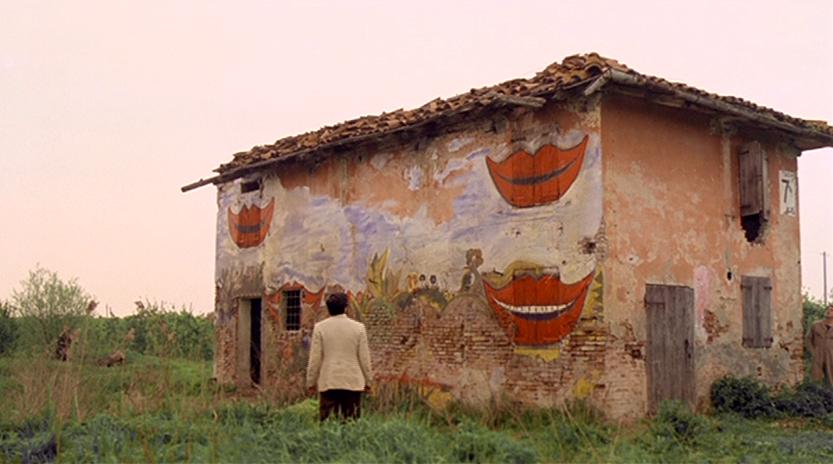
This is why you always do an on-site visit before signing a lease.
Stefano and Coppola take the motorcycle back to his place. Coppola waits with the motor running outside while Stefano runs in to retrieve his luggage and Francesca. But he can find no sign of her! He runs up to the paraplegic woman’s room and finds it empty. Then he runs upstairs to the secret room to find a wig on the stairs and something even more horrible than a bad wig in the room itself. Francesca is dead, hanging by her arms from a hook in the ceiling, her nightgown stained with blood. Stefano cries out over his repeatedly stabbed love. He runs outside to the front door, but Coppola is now gone, too. Only the motorcycle is left, so Stefano thieves it.
Stefano retrieves the police marshals and brings them to the murder room in his house. But it’s somehow completely empty and pristine. Not a drop of blood in the place. He figures Francesca’s body must be buried by the house with the laughing windows, so he leads the police there next. They dig a pretty substantial hole but find nothing – no Francesca, not even the bones Coppola dug up hours earlier. (However, the camera zooms in on a jawbone as they leave, so they’re not the most observant police officers.) Some police in gondolas discover Coppola drowned in the ravine by the church. He’s covered in scars that the police marshall attribute to his time in the war. The marshall insists that Stefano stay in town one more night and meet with him for an interview in the morning.
Stefano returns to the village hotel and gets a phone call – of course he does – again. But this time, it’s Francesca on the other line, asking him to come to the house. She’s scared. But isn’t Francesca dead? (A quick crosscut reveals that “Francesca” is really just a recording of the dead woman on the other end of the line.) But Stefano, with all he’s seen in the past couple days, has moved beyond logic. He hops onto Coppola’s motorbike and returns to his terrible, terrible house. Upon arrival, he hears a man screaming, so he races up the stairs to that secret death room. Inside, the two sisters are very graphically stabbing Lidio, who is hanging from the same hook Francesca did.
The one sister, the paraplegic woman who lived upstairs, explains that she and her sister (whose face we don’t see) have preserved their brother Legnani. She opens a cabinet and inside is a corpse, floating in a glass case filled with formaldehyde. The tape recorder rests beside the cabinet, preserving his voice. The sisters still regularly bring Legnani victims. However, Lidio raped and killed Francesca, ruining whatever dark plans they had for her, so he must be punished. (Hence, all the stabbing.) Just as the one sister is explaining their evil plot, the other sister stabs Stefano in the chest. He screams, chest spurting blood, and runs from the building. They chase him into the woods outside the villa, but he evades them in the dark.
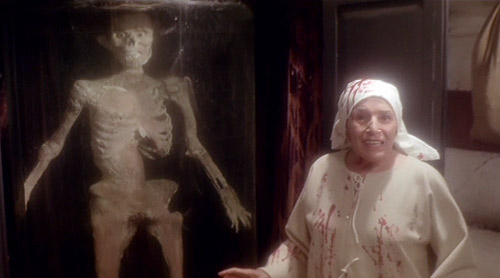
The House with the Laughing Windows: host of many creative alternatives to the ho-hum burial.
When the coast is clear, the wounded Stefano hops on the motorcycle – good thing that motorcycle is blood red – and rides back into town. He bangs on several doors, seeking help, but none of the villagers will open the door for him – not Mr. Poppi, not even Mayor Solmi. The one villager who does maintain an open door policy is the priest. He lets him into the church and sits him down. Stefano breathily tells the priest that Legnani’s sisters are still alive and very stab-happy. He says one sister is the paraplegic woman from the villa, but he didn’t get a good look at the other one. The priest’s voice then changes – becomes more feminine – when he says, “That’s a nasty wound. It would make a beautiful painting.” The priest then removes his vestments, revealing a bloody smock and bare woman’s breast. The priest is the other Legnani sister. Stefano’s eyes bug in disbelief and the priest laughs hysterically.

Mothers, don’t let your boys grow up to be art restorers.
Takeaway points:
- One thing that differentiates The House with the Laughing Windows from many other gialli is the constant reference to World War II, and Nazis having used the village as a staging area of sorts. This, combined with the hidden horrors that happened in the town, seem to implicitly link Italy with the horrors of the Third Reich in a way that few Italian horror movies do. (Unless you consider, say, The Conformist, a horror movie.) The church was used by the S.S. The hotel porter notes they haven’t seen tourists since the Nazis. The shadow of the war looms large over The House with the Laughing Windows and naturally acts as the subtext to the murders and torture the sisters commit: the jawbone in the dirt seems too glaring a symbol. The sisters even fled to Brazil at a certain point (as history suggests some principal Nazis did following the war). Most telling is the penultimate scene, when Stefano seeks help from the villagers, and they all pretend to suddenly fall deaf. “At first, they came for the fresco restorers …” That the Catholic church ends up being the final architect of his doom is no accident either. The House of Laughing Windows can easily be read as an allegory of Italian collaboration with the Third Reich.
- When you don’t watch a giallo movie for a while, you forget just how rampant the causal misogyny is, from the implication that a teacher who enjoys casual sex is a sex worker to our hero Stefano’s abysmal treatment of his girlfriend. Lidio can’t even talk about a bicycle without being misogynist. “This bicycle is the son of a scooter and a whore,” he sings. It can become difficult to handle. Especially when you combine this causal misogyny with the much more explicit misogyny of the sexual assault and murder that frequently occurs in a giallo.
- Saint Sebastian is more commonly depicted as being tied to a tree and shot to death with arrows. In Legnani’s fresco, Sebastian is being stabbed repeatedly with knives by two murderers in particular. Interestingly, he is the patron saint of Rio de Janeiro (!). (He is also the patron saint of athletes, but no one in the film – no offence – looks overly athletic.)
- Please see the takeaway points from Deadly Blessing regarding slasher movies and transphobia, because it applies to The House with the Laughing Windows, as well. The priest, posing as a man, is in reality one of Legnani’s sisters. And the horrific reveal, to Stefano, is that this priest has a mammary gland. This is the mirror image of the same problematic message that runs under the reveal at the end of Deadly Blessing.
- I don’t pretend to be a liturgical scholar, but I’m pretty sure that in 1976, people who committed suicide were denied Catholic funerals. So why does Antonio, who is believed to have jumped to his death, receive a funeral in the church? Or should this have been a warning sign for Stefano that the priest was not who he seemed?
Truly terrifying or truly terrible?: Pretty terrifying, if I’m being honest. I was unsettled. Most giallo are long stretches of boring exposition and dialogue that rivals softcore pornography for inanity, punctuated by inventive and visually explosive murders, but The House with the Laughing Windows is tenser than most. Rather than being dull, the sequences between the murders is often unbearably suspenseful, soaked with a slowly building dread. If I were Francesca, I wouldn’t have lasted as long in that house as she did. I’d have dumped Stefano after the first night.
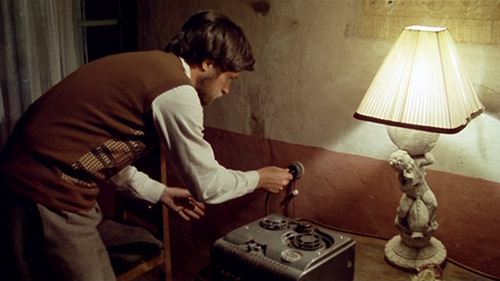
Stefano has in-VEST-ed a lot of effort into this mystery by this point.
Best outfit: Stefano brings with him to the village the most incredible collection of patterned vests. You can tell he studied art in school.
Best line: “There’s probably more alcohol than water in his body.” – the police, with some sensitive remarks, upon finding Coppola’s drowned body
Best kill: The stabbing is quite graphic and torture-porny, but I can’t pretend there wasn’t a nice sense of justice that accompanied seeing the monstrous Lidio being killed.
Unexpected cameo: After a very brief career as an actress, Francesca Marciano went on to a fairly successful career as a screenwriter, with dozens of film credits to her name, including a couple of American-language films, like the recent Benicio del Toro / Josh Hutcherson vehicle Escobar: Paradise Lost.
Unexpected lesson(s) learned: Take the early train. You’ll be tired, but you can sleep on the train.
Most suitable band name derived from the movie: Painters of Agony
Next up: Candyman (1992).
